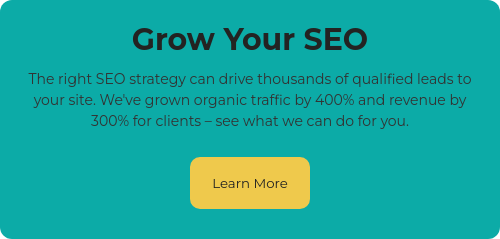SEO and keywords go hand-in-hand, right?
If you've ever written content with an aim to increase search engine traffic, you've probably followed a process like this:
-
Research the heck out of keywords people might use related to your products and services
-
Use a tool like SEMrush, Ubersuggest, or AHREFs to determine keyword search volume
-
Pick the keywords with the highest search volume and lowest competition
-
Write content around those keywords
This has been the standard approach to content SEO for a long time, and sometimes it works really well. But if this is still the extent of what your brand is doing in 2020, then I have to tell you—it's not enough.
Google's Evolving Treatment of Keywords
As search engines like Google have evolved, so has the importance of individual keywords in SEO. There was a time long ago when website owners could just stick their keywords in a meta tag and get on with it. Later, writers worried about keyword frequency: making sure a specific phrase showed up a certain number of times. Then, it was making sure you included a variety of relevant keywords in context.
In recent years, the emphasis behind Google algorithm updates—including 2019's BERT, their most significant update in five years—has shifted from the more straightforward use of keywords to something much more sophisticated:
How valuable is your content, and how well does it fulfill a searcher's need?
What does this mean for content creators? You can use a particular keyword or set of keywords all over a piece of copy, but if that content doesn't say anything new or useful, then you're still not likely to rank for much. You need to understand what the searcher is searching for—the "user intent"—and provide the content that serves that need better than your competitors.
Why a Keyword-Based Strategy is no Longer Enough (And Hasn't Been for Awhile)
An increased emphasis on quality and relevance
Google's BERT update may have a complicated name ("Bidirectional Encoder Representations from Transformers," of course 😉), but BERT is just another step in achieving one of Google's most important goals: creating an algorithm that interprets language like humans do. This means Google better understands a searcher's query and can better match it with the content that will fulfill the searcher's need.

An example from Google of results pre- and post- BERT. As you can see, the #1 ranking now better matches the likely intent of the searcher.
Because Google now better understands the context behind a search, the specific keywords targeted aren't as important as whether or not a content piece appropriately fulfill's the searcher's intent. At First Page, we've seen this translate into a shift in keywords for clients, with content ranking better for the keywords that best fit the searcher intent behind a piece, and keywords that don't match the intent dropping off. If you've built your content strategy around the needs of your customers, this should result in more relevant traffic. If not, then you've got some work to do!
Devaluing of duplicate content
The fact that Google doesn't like duplicate content shouldn't be anything new to you. But you may have thought of duplicate content only in terms of copied content—places where your copy is word-for-word the same. You should also be considering content with duplicate intent.
One of the side effects of building a content strategy strictly off keyword variations is that you run the risk of creating two pieces of content that essentially fulfill the same need. A sunglass brand's blog post written for "what do polarized sunglasses do" and one written for "what is polarization" may not be copies, but in this case, they could be targeted towards the same search. Having two blog posts compete with each other for searches in Google could end up hurting both.
More competition for clicks
If you're watching your brand's Search Console metrics, you may have noticed changes in click-through rates over the last few years, even if your average ranking position has stayed the same. The addition of featured snippets and other "enhanced listings"—like "People Also Ask" questions—has pushed "regular" organic listings down. Take this example for the search "how to restain furniture:"

Lowe's ranks #3 for this search term, a ranking SEOs would traditionally consider a success, since keywords in spots 1-3 tend to get the most clicks. However, on a smartphone, the #3 result doesn't actually appear until a searcher has scrolled down 4 pages. The searcher has to make it through their personal "related activity," video suggestions, and "People Also Ask" questions before they even get to the normal organic results. A #3 result for a major keyword likely won't get you the same results it used to.
How does this relate to how we build content strategy? It means creating content around high volume keywords isn't enough to get clicks. To drive meaningful traffic for your brand, you need to not only incorporate the schema and multimedia content that will help you get enhanced listings, you need to shift your focus towards long tail keywords with less competition—those that better match the search intent of your customers.
More sophisticated searchers
As Google gets better at delivering the content to meet searchers' needs, the searcher in turn begins to expect content that answers their specific question. Whats more, the prevalence of Siri, Alexa, Google Home, and other voice-search mechanisms has shifted the way people search, making their language more conversational and often more oriented around questions than keywords. The result? The keywords people actually use are more varied than ever, and it's impossible for brands to target every single variation of a phrase. However, we can target the intent behind a search and create the content that will serve the needs of our unique customers.
How to Build Content Around User Intent
Okay, so how do we shift our focus from keywords to user intent? Revising your strategy may mean some upfront work, but in the long term you'll find your content is much more effective, both in search engines and with customers.
-
Understand your audience
To provide value to your customers, you need to understand what they're looking for. This means talking to them on a regular basis and discovering how they're using your product or service, what brought them to you, and what they still need. It's not enough to understand how someone first becomes a customer—understand why they stay (or don't stay), why they refer you to others (or don't refer you), and how you can support them throughout the lifecycle of the partnership.
As Eli Schwartz, Growth Consultant and Advisor, says in Search Engine Journal, “Content will truly have to be written to user intent rather than just strings that a user might search [...] In 2020, the really smart SEOs will get up from their desks to talk to customers so they can find out what their audience really wants from them.”
Truly understanding your audience means you can speak to their needs and deliver what they're looking for -
Think in terms of needs, questions, and pain points
As you develop a content calendar, don't think about what words the masses are searching for—think about what your potential customers are asking and how you can solve their problems. Framing content development in terms of questions ensures you provide answers, enhancing the value of your content (and helping you convert customers).Over at Grow & Convert, Benji Hyam argues for a "pain-point driven" SEO strategy:
“By doing SEO from a pain point first approach vs. a keyword-first approach, we can map the intent of the search to the buyer’s journey and have a better predictor of which SEO posts will generate leads and signups, instead of just measuring which posts will generate traffic.”

This approach means you're thinking about how your particular product or service serves the needs of your audience, keeping content relevant, focused, and useful.
There are several tools out there that help you identify questions related to given topics—SEMrush's Topic Research tool, Answer the Public, and Google Suggest, just to name a few.
3. Map your content to user intent
Once you've identified your customer needs and pain points, you can start to map both existing and future content to fulfilling those needs. If you already have content designed to fill a user/customer intent, great—see how you can make it better, or see if there's another format (video, infographic, interactive content) that customers might like more.
In some cases, you may find you have multiple pieces of content designed to fulfill the same purpose. These can be combined, archived, or redirected so that you have one strong piece of content to meet a searcher's need, instead of multiple that are competing with each other.
If you don't already have content to match a particular intent, then see how that topic can be covered in a way that truly showcases your product, service, or brand expertise.
4. Still do keyword research—just do it later in the process
Keywords aren't obsolete. It's still useful to understand the phrases people search for and to optimize your content accordingly. Do your keyword research after you've narrowed down your topics so that the focus is on the needs of your customer, not a keyword.
It can be helpful to group keywords into "intent buckets," where all the different variations of the keyword represent the same searcher/user intent, and they're all served by one piece of content.
...and don't worry as much about keyword volume.
When doing keyword research from an intent perspective, it's important to remember that keyword volume may not be as important. With content, our goal is often traffic—however, getting lots of traffic doesn't mean anything if it's not the right traffic to achieve your brand's business goals. As we discussed above, the SERPs are getting more-and-more competitive. Focusing on customer questions and longer-tail keywords with lower search volume helps us get more directly to user intent than large head keywords. They may result in less traffic, but the traffic you're getting is more likely to convert.
Developing a good content strategy is a challenge, but focusing it on customer intent has benefits across channels, from SEO to conversion to customer experience.






